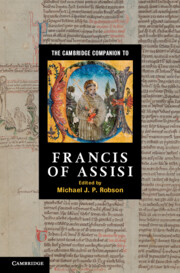Book contents
- Frontmatter
- Introduction
- PART I Francis of Assisi
- 1 Francis and the Franciscan movement (1181/2–1226)
- 2 The writings of Francis
- 3 The Rule and life of the Friars Minor
- 4 Francis and his hagiographical tradition
- 5 Voluntary simplicity: the attitude of Francis towards learning in the early biographies
- 6 Francis and the historiographical tradition in the order
- 7 Francis and Clare and the emergence of the Second Order
- 8 Francis and the encounter with the sultan (1219)
- 9 Francis and creation
- PART II The heritage of Francis of Assisi
- Index
1 - Francis and the Franciscan movement (1181/2–1226)
from PART I - Francis of Assisi
Published online by Cambridge University Press: 28 November 2011
- Frontmatter
- Introduction
- PART I Francis of Assisi
- 1 Francis and the Franciscan movement (1181/2–1226)
- 2 The writings of Francis
- 3 The Rule and life of the Friars Minor
- 4 Francis and his hagiographical tradition
- 5 Voluntary simplicity: the attitude of Francis towards learning in the early biographies
- 6 Francis and the historiographical tradition in the order
- 7 Francis and Clare and the emergence of the Second Order
- 8 Francis and the encounter with the sultan (1219)
- 9 Francis and creation
- PART II The heritage of Francis of Assisi
- Index
Summary
HISTORIOGRAPHY AND HERMENEUTICS
Francis of Assisi is one of the most popular and attractive saints of Christian history. And yet therein lies the challenge for those attempting to authentically understand him and the movement which gathered around him. In popular and scholarly treatments Francis and his spiritual achievement are often understood in isolation from the historical conditions and realities which gave rise to the man and the movement he inspired. Such works concentrate instead either on his heroic and saintly virtues of simplicity, humility and poverty or on his fate as an isolated victim of manipulative clerics intent on using his movement to advance their own ecclesial agenda. In either case concentration is fixed upon the man to the exclusion of the multi-faceted movement.
The reason for this is not simply our genuine fascination with il poverello. It is also closely tied to the fact that our understanding of him has either been drawn largely from the hagiographical sources of the thirteenth and early fourteenth centuries, which viewed him through the lens of his canonisation as a saint in 1228; or, alternatively, from the personal reminiscences of his companions which reflected the polemical struggles raging within the order over its identity and its fidelity to the intentions of the founder.
- Type
- Chapter
- Information
- The Cambridge Companion to Francis of Assisi , pp. 15 - 33Publisher: Cambridge University PressPrint publication year: 2011



